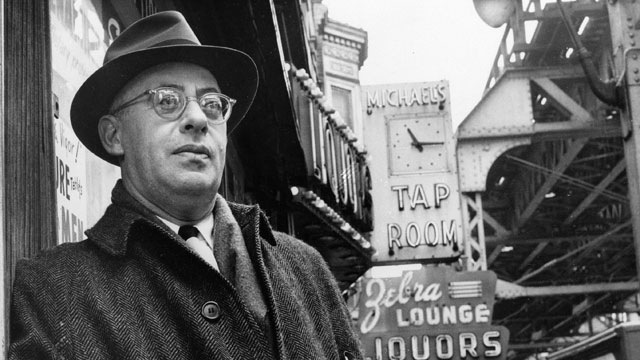
Saul Alinsky on Chicago’s south side, where he organized the Woodlawn area to battle slum conditions. Feb. 20, 1966 (AP)
The way Newt Gingrich refers to the connection between Barack Obama and Saul Alinsky, one might think the president and the community organizer were golf buddies… except for the stubborn fact Alinsky died in 1972 when Obama was 10.
Among Gingrich’s quotes: “Obama believes in Saul Alinsky and secular European socialist bureaucracy.” And “Saul Alinsky radicalism is at the heart of Obama.”
Two things Obama and Alinsky do have in common are their Chicago home bases and parts of their resumes. As NPR puts it, “President Obama proudly talks about his days as a community organizer in Chicago, and the late Chicagoan Alinsky ‘wrote the book’ on community organizing.”
“My only fixed truth is a belief in people, a conviction that if people have the opportunity to act freely and the power to control their own destinies, they’ll generally reach the right decisions.”
— Saul Alinsky to Playboy, 1972
Born in Chicago in 1909, the child of poor Russian Jewish immigrant parents, Alinsky majored in archaeology at the University of Chicago and later became a criminologist. But Alinsky’s true calling came in the late 1930s when he began work as a labor organizer. Later, he focused his attention on organizing communities against substandard living and working conditions in places including Chicago’s depressed Back of the Yards neighborhood, made famous in The Jungle by Upton Sinclair.
After being mentored by the powerful labor leader John L. Lewis, Alinsky founded the Industrial Areas Foundation (IAF), which trained community organizers around the country. With the financial backing of liberal millionaire Marshall Field III, Alinsky was able to expand his mission of inspiring and organizing poor, urban communities across the nation. His first book Reveille for Radicals, published in1946, became a best-seller, and is considered a handbook for social change.
Sanford Horwitt, who wrote Let Them Call Me Rebel: Saul Alinsky, His Life and Legacy, told NPR that Alinsky “wanted to see especially lower-income people who were getting pushed around to exercise some influence and even power over decisions that affected their lives.”
“As an organizer I start from where the world is, as it is, not as I would like it to be. That we accept the world as it is does not in any sense weaken our desire to change it into what we believe it should be – it is necessary to begin where the world is if we are going to change it to what we think it should be. That means working in the system.”
— Saul Alinsky in Rules for Radicals
Alinsky’s tactics were unusual, humorous, and provocative. In his book Rules for Radicals, Alinsky describes the role of the organizer “to maneuver and bait the establishment so that it will publicly attack him as a ‘dangerous enemy.'”
But though his means and methods have been and continue to be adopted by political groups, Alinsky was no fan of affiliations.
“I’ve never joined any organization — not even the ones I’ve organized myself,” Alinsky told Playboy in 1972, shortly before his death. “I prize my own independence too much. And philosophically, I could never accept any rigid dogma or ideology, whether it’s Christianity or Marxism…The greatest crimes in history have been perpetrated by such religious and political and racial fanatics, from the persecutions of the Inquisition on down to Communist purges and Nazi genocide.”
By the 1950’s, Alinsky’s main focus was organizing African-American communities. He brought modern civil rights efforts to Chicago and helped the black community of Rochester, New York challenge the mighty Eastman Kodak’s hiring policies.
During the 1960’s Alinsky set up institutes to train other organizers, and his reputation as a visionary organizer and activist began to spread. None other than Hillary Clinton chose his work as the topic for a Wellesley College thesis in 1969. According to a 2007 Boston Globe article, Clinton interviewed Alinsky twice for the paper, which was entitled “There is Only the Fight: An Analysis of the Alinsky Model.”
In it, Clinton writes, also according to the Globe, “Much of what Alinsky professes does not sound ‘radical.”… His are the words used in our schools and churches, by our parents and their friends, by our peers. The difference is Alinsky really believes in them and recognizes the necessity of changing the present structures of our lives in order to realize them.”
Alinsky published his third book, Rules for Radicals, A Pragmatic Primer for Realistic Radicals, in 1971, and it’s become popular even outside the communities and audiences he called his own. One prominent example: Dick Armey’s FreedomWorks, a conservative advocacy organization that assists tea party groups, has distributed Alinsky’s books in training sessions.
Saul Alinsky died of a heart attack in 1972, but his legacy lives on not only through the work of the IAF — now represented by 47 organizations across the country – but through the tactics of grass roots groups on all sides of the political playing field.
Still, Alinsky likely never would have imagined his most popular days would arrive exactly ten years after his death, as the shallow buzzword of a politician on the ropes.
Explore More:
The Democratic Promise: Saul Alinsky and his Legacy is a 1999 documentary produced and directed by Bob Hercules and Bruce Orenstein. Narrated by Alec Baldwin, the film shows how Alinsky championed new ways to organize the poor and powerless that created a backyard revolution in cities across America. In this clip, Baldwin tells the story of Alinsky’s help in organizing the black community in Rochester, NY.

